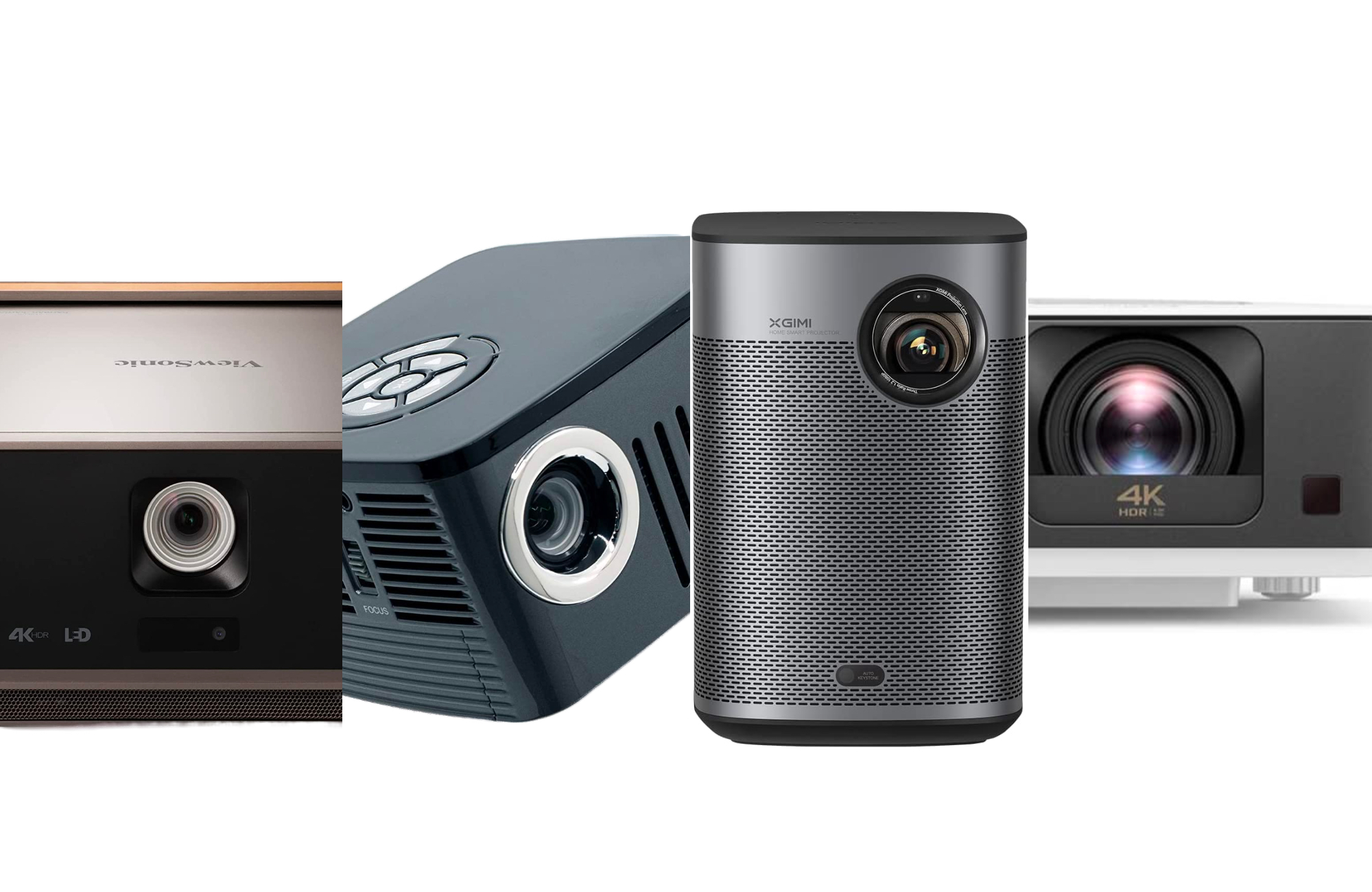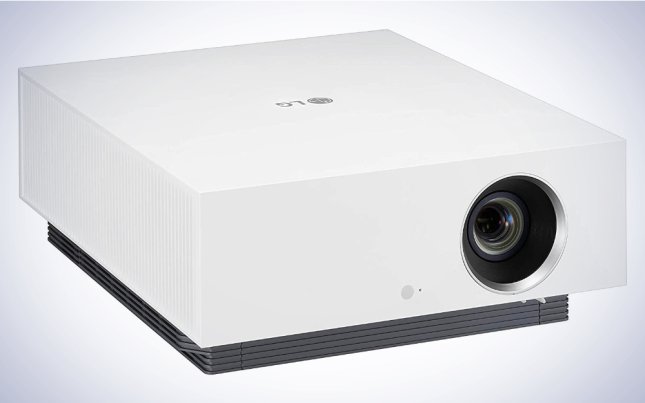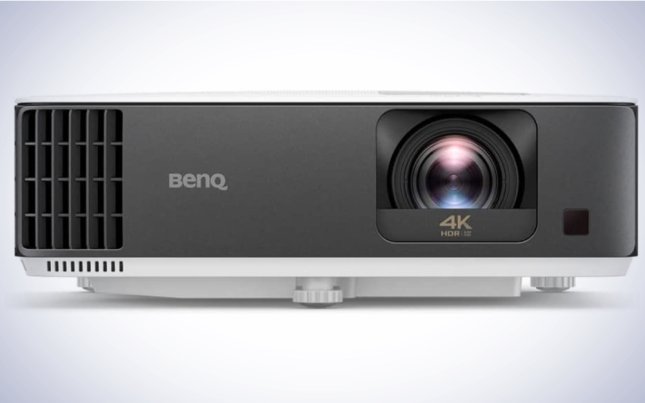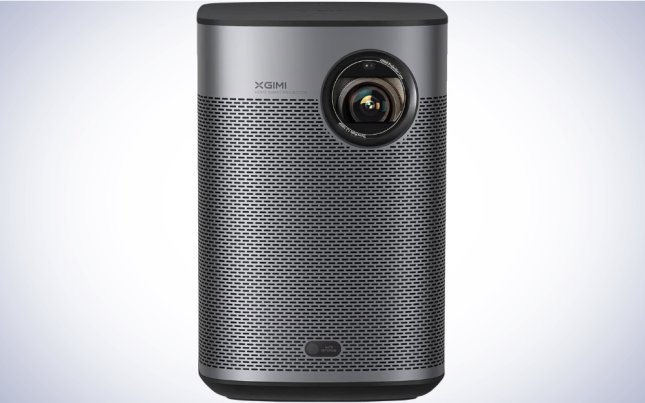We may earn revenue from the products available on this page and participate in affiliate programs. Learn more ›

Projectors used to feel like the type of gadget that was only accessible to people with a lot of space, disposable income, or both—thankfully that’s no longer the case. It’s possible to get a projector at virtually any price that will work in rooms both big and small. In fact, one of our picks only needs to be about a foot or so away from your wall to make a picture far bigger than even the largest of TVs. There’s still a time and a place for those, but you should seriously consider getting one of the best projectors if you’re building out or upgrading a home theater space.
- Best overall: LG HU810PW
- Best 4K: Dangbei Mars Pro 4K
- Best for gamers: BenQ TK700STi
- Best portable: XGIMI Halo+
- Best budget: AAXA P7 Mini
How we chose the best projectors
We canvased the entire portfolio of every major projector maker to determine the very best projectors for both general and specialized use cases. Our assessments factored in the size and lighting situation of your room, both of which play a huge part in performance. Finally, value was a big consideration—we made sure the projectors in our guide offered the most features for their cost.
The best projectors: Reviews & Recommendations
Whether you’re ditching your 4K TV for an even bigger screen, or are finally fitting out the home theater system of your dreams, our projectors will prepare you for almost every type of viewing experience.
Best overall: LG HU810PW
LG HU810PW
Pros
- High native resolution
- Massive maximum screen size
- Excellent port selection
Cons
- Expensive
Buy it used or refurbished: eBay
Specs
- Resolution: 4K
- Ports: 3 HDMI, 1 USB-A, 1 optical audio, 1 Ethernet
- Screen size: 300 inches
If money is no object, and you’re after the best possible projector for any use case, LG’s HU810PW is the one to get. The 4K projector has an ultra-bright 2700-lumen bulb, which means you’ll be able to use it in a room that has moderate light leakage (think sun seeping in through closed blinds) without a derogated picture. The projector even has dedicated bright and dark modes, which adjust the picture settings based on how much outside light is in the room. You’ll also be able to watch 4K TV shows and movies with no loss in quality, which is important if you’re a stickler for video definition.
The HU810PW supports HDR (high dynamic range), a technology that improves contrast and color quality, which makes video look more realistic. LG developed a technology called Adaptive Contrast, which takes this concept further by automatically adjusting the projector’s brightness level in real time based on the scene you’re watching.
LG’s use of forward-thinking technology extends to this projector’s software. The HU810PW runs WebOS, an operating system that allows you to natively run streaming apps without requiring you to plug in a media streamer. It also supports AirPlay 2, Miracast, and Bluetooth, so you can send media to it wirelessly from your phone. These wireless technologies are complemented by the HU810PW’s assortment of HDMI and USB ports, which make it possible to connect several gadgets to it simultaneously. Crucially, one of the HDMI ports is an eARC (Electronic Audio Return Channel) port, which allows you to route audio from connected components through an A/V receiver.
All of these luxe features will make a big difference in your viewing experience, but they also increase the HU810PW’s price. We still consider it to be a great value based on the technology inside, especially since it can produce a 300-inch image when it’s far away from a wall, but it’s absolutely an investment. Still, if you want a true movie theater-like experience at home, this is the projector to get.
Best 4K: Dangbei Mars Pro 4K
Dengbei Mars Pro
Pros
- Ultra bright
- Excellent color reproduction
- Surprisingly good speaker system
Cons
- Expensive
Specs
- Resolution: 4K
- Ports: 2 HDMI, 1 USB-A, 1 Ethernet, 1 Optical audio input
- Screen size: 300 inches
Danbegi’s Mars Pro 4K is an investment, but one that gamers and movie lovers alike should seriously consider making.
The projector’s brightest spot—literally—is its 3200 lumen bulb, which allows the Mars Pro 4K to show a clear picture in rooms with a fair amount of light pollution. We still wouldn’t recommend using this projector in a room with lots of windows at high noon, but you don’t have to wait until night to turn it on. If you’d like to set your home theater up in a living room rather than basement, you’ll be fine.
It only took a few minutes to set up Danbei’s Mars Pro 4K projector, a process that included connecting the machine to my home Wi-Fi network, and walking through some basic setup steps. Once completed, I was shown a straightforward user interface, which allowed me to easily adjust audio and video settings, adjust the projectors focus, and check for updates. You can’t stream media directly from the Mars Pro—you’ll need to plug a media streamer into one of its HDMI ports for that—but the company offers a bundle with a 4K streaming dongle running Android, which is what I’m recommending.
I tested this projector using that Android dongle, another media streamer, and playing Nintendo Switch games, and had a universally positive experience. The Mars Pro is a 4K projector that supports HDR (high dynamic range), and our experience watching HD and ultra high definition content was fantastic. Colors popped, and there was a great amount of detail present even in HD footage and games.
The screen I projected was roughly 100 inches, and yet the projector’s focus kept the entire frame looking sharp. Similarly, the Mars Pro 4K’s audio system delivered a nice punch, though did sound a little treble heavy at the highest volume levels. That said, you won’t need to connect this projector to a speaker system.
Any cinephile or gamer will immediately appreciate what the Danbei Mars Pro 4K has to offer. If you pick one up, it’ll immediately become the centerpiece of your home theater system, and one you won’t think about upgrading for a long, long time.
Best for gamers: BenQ TK700STi
BenQ TK700STi
Pros
- Ultra bright bulb
- Supports higher frame rates
- Runs Android TV
Cons
- Expensive
Specs
- Resolution: 4K
- Ports: 2 HDMI, 1 USB, 1 audio out
- Screen size: 150 inches
Gaming on a projector is a completely different experience compared to using a TV, and it’s hard to go back once you get used to playing on a 100-plus-inch screen. BenQ designed the TK700STi to optimize its performance for console and PC gaming, so you’ll have a good experience regardless of your preferred platform. Playing games is all about visual fidelity, which is why the TK700STi has a 4K resolution and supports HDR. Both of its HDMI ports follow the 2.0b standard, which allows you to play games at up to 120 frames per second, depending on your resolution. One of the TK700STi’s HDMI ports acts as the ARC, so you can hook it up to an A/V receiver to play in surround sound. BenQ created a dedicated game mode for this projector to minimize lag—important when playing fast-paced games like first-person shooters.
All of these technical details will appeal to gamers, but the TK700STi is an impressive projector even when the controllers are down. Its 3000-lumen bulb tackles challenging environments for viewing in all kinds of sunlight. It runs Android TV, so you can run streaming apps directly from the projector, or stream video to the TK700STi’s built-in Chromecast. These convenient features aren’t necessary, but they extend the TK700STi’s appeal to non-gamers. If you don’t have a current-generation console, but plan on getting one in the future, the TK700STi is worth the investment. We chose that word carefully because this projector costs $1,500.
That said, the TK700STi is a good all-around projector whose specific features make it a particularly good choice for gamers with cutting-edge hardware.
Best portable: XGIMI Halo+
XGIMI Halo+
Pros
- Bright bulb
- Powerful speaker system
- HDR support
Cons
- So-so battery life
Specs
- Resolution: 1080p
- Ports: 1 HDMI, 1 headphone jack, 1 USB-A
- Screen size: 120 inches
Getting a portable projector used to mean making a lot of technical compromises for the sake of a wire-free experience, but XIGIMI’s Halo+ proves that’s no longer. This 1080p projector can create a 120-inch screen, supports HDR, has a built-in 10W stereo speaker system designed by Harman Kardon, and runs Android TV. It’ll run for up to two hours per charge, which is enough time to make it through the average movie or a few TV show episodes with a little time to spare.
A big part of the Halo+’s appeal is its all-in-one design. You can stream videos directly to the projector from a streaming service or your phone, and watch it without any other hardware. One of our typical complaints with portable projectors has been the quality of their built-in speaker, but that’s not the with XIGIMI’s hardware thanks to its Harman Kardon partnership. If you decide to use the Halo+ indoors, you’ll appreciate the fact that its sole HDMI port can be used as an ARC.
Our only real complaint with the Halo+ is its battery life. Yes, this is a small projector with a surprisingly bright 900-lumen bulb and a comparatively great sound system, but you’ll still have to worry about topping it up fairly regularly. Regardless, this projector’s technical features are impressive for a model you can take anywhere.
Best budget: AAXA P7 Mini
AAXA's P7 Mini
Pros
- Portability
- Built-in speaker
- Price
Cons
- Not 4K
Specs
- Resolution: 1080p
- Ports: 1 HDMI, 1 USB-A, 1 headphone jack, 1 A/V input, 1 MicroSD card slot
- Screen size: 120 inches
Whether you need a projector for light gaming, office use, or casually watching videos, the AAXA’s P7 is the only projector we recommend. The ultra-portable 1080P projector can fit in a backpack, briefcase, or purse, and run on battery power for up to 90 minutes. AAXA managed to fit several inputs onto the P7 despite its small size, including one HDMI port, so you can connect most laptops or a media streamer to it without an adapter. You can also store videos on a USB thumb drive or MicroSD Card to play them directly from the projector itself. We’re also very impressed that the P7’s bulb is 600 lumens—that’s far brighter than we’d expect from a pint-sized portable projector. There’s even a built-in speaker, which will come in handy in a pinch. However, it’s not beefy enough to create robust audio like a sound bar.
There are a handful of limitations to the P7: its maximum screen size is lower than full-sized projectors, it’s only HD, it doesn’t support HDR, and it doesn’t run an operating system.
What to consider when buying the best projectors
If you love watching movies and TV shows or playing videogames, a projector will offer an immersive, cinema-like experience that’s totally engrossing. However, shopping for one isn’t as straightforward as walking right to the electronics section of your favorite bix box chain. Here’s what to know when screening the best projectors:
Light pollution and bulb brightness
The amount of light in your room will have a huge impact on the performance of your projector. If your home theater system is in a basement or a room with light-blocking curtains, a projector is a great alternative to a TV. If the room has a lot of natural light throughout the entire day, you’ll only be able to use your projector at night, limiting its appeal.
Light pollution can wash out their ability to project a picture, making it look washed out or otherwise harder to see. The brighter the projector’s bulb (measured in lumens), the less susceptible it is to light pollution. Think of it this way: All projectors will struggle in a room with a lot of light, but brighter ones will perform better in a room with moderate or dim lights. If you only plan on using your projector in totally dark environments, its luminosity won’t matter as much, but it’ll still impact the overall quality of its image.
Wall space
A projector requires a large, empty, white-painted wall to work best. If your wall is cluttered with stuff, you’re better off getting a TV unless you’re okay with installing a separate projection screen.
Resolution
This is the most tricky metric to consider when picking up a projector because of how some companies use this term. A projector’s native resolution will determine the overall quality of its image. For example, a projector with a native resolution of 1080p will be able to play back an HD video at its full quality. A projector’s maximum resolution determines the highest quality video that can be fed into it, regardless of its native resolution. If a projector has a maximum resolution of 1080p (high definition), but a native resolution of 480p (standard definition), it’ll play back your HD video at a non-HD resolution, which will look grainy or pixelated. All of our projector recommendations have a native resolution of 1080p or 4K, so you don’t have to worry about image quality.
Throw distance
A projector’s throw distance determines how big of a picture it can make based on how far it is from a wall. “Short throw” style projectors can be very close to a wall while still making a very large picture, which makes them ideal for smaller rooms. A standard projector will work best when it’s installed between eight and 10 feet away from your wall.
Maximum screen size
All of the projectors we’re recommending can create a picture that’s over 100 inches long depending on how far it is from your wall. Some models can create a picture that’s even larger without suffering any loss in quality.
Port selection
A projector’s ports determine the types of components (e.g., game console, Blu-Ray player, media streamer) you can plug into it. All of our projector recommendations have at least one HDMI port, which is the universal standard for HD A/V hardware. Some projectors also have a headphone jack or other audio out port, which allows you to connect them to external speakers for better sound.
Built-in speakers
Many of the projectors in this guide have built-in speakers, which is useful if you’re prioritizing portability over audio quality. Projector speakers used to be subpar, but many companies have partnered with speaker makers to design custom-built audio systems that produce surprisingly rich sound. That said, you’ll still want to hook your projector up to a proper home theater system if you want to experience surround sound.
Smart features
A lot of newer projectors have useful smart features, like running an operating system that allows you to access streaming apps directly from the device. A projector with a built-in operating system will leave all of its HDMI ports free for external components since you won’t need to connect a media streamer.
Portability
Most projectors are small and light enough to be taken from one place to another but require a nearby outlet for power. A battery-powered projector allows you to host outdoor movie nights without a single cable.
FAQs
This depends on the features you prioritize, but you can get a projector for as little as $60 or as much as $2,000.
When it comes to the best home projectors, 4K projectors have the highest image quality around. With a 4K model, you will get a horizontal display resolution of approximately 4,000 pixels, which translates to an image that will look sharp, vivid, and brilliantly colored. This is what you would expect to see in a movie theater, but can now have at home.
It depends on the native resolution of the projector and your definition of cheap. It’s possible to get a projector with a native HD resolution for well under $500, and the price of projectors with this feature continues to fall.
While you can pick up pretty much any projector, if you are looking for one you can conveniently bring around town then you will want one that is specifically made to be portable. Larger designs will be fairly heavy and delicate, and not something you want to be thrown in a bag. If you plan to visit family and friends, or lead presentations in various satellite offices and convention halls, etc., definitely consider the size (some mini projectors, known as pico projectors, even fit in the palm of your hand).
Final thoughts on the best projectors
The best home projectors offer the experience of a multiplex, but at home. Whether it’s outdoor BBQs with family videos playing, gaming in-between commercials during the big game with friends in the garage, or a replacement to a TV for home entertainment use, the best projector will offer incredible image quality at a larger size than most televisions (with the benefit of being compact, portable, and easy to pack away). With so many streaming options now, it’s a great time to get a projected screen worthy of a theater.
- Best overall: LG HU810PW
- Best 4K: Dangbei Mars Pro 4K
- Best for gamers: BenQ TK700STi
- Best portable: XGIMI Halo+
- Best budget: AAXA P7 Mini








